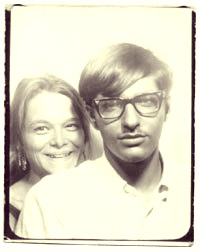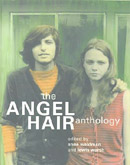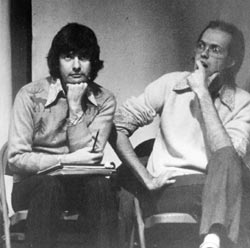|
Tom, Angelica and Juliet Clark on Bolinas Beach, CA, 1969.
Photo by Bill Beckman, © Tom Clark 2001. Courtesy of Tom Clark
I’m leaving out others. Ted was there every night until he left to teach in Iowa in 1968. Sandy Berrigan often visited by day, with her two children, David and Kate. Joanne Kyger showed up one afternoon after she moved to the city with her husband Jack Boyce, and Jim Carroll was a constant self-contained presence, straight out of high school. Bill Berkson was there often, especially after he moved from East 57th to his apartment around the corner on 10th Street.
Alongside the salon atmosphere, a little publishing industry was rumbling in our living room. We had begun doing books by then — the English poet Lee Harwood’s The Man With Blue Eyes was the first, followed by Gerard Malanga’s 3 Poems for Benedetta Barzini. It was a natural progression to go from magazine to books, a furthering of the commitment to the writers that interested us most. In retrospect I think Anne and I were intent on mining all the possibilities of being editors and publishers as quickly as possible so that we could get on with our own work and whatever was to follow. Some nights we wouldn’t answer the door just to get stuff done but Ted had a special code for our buzzer — he was always welcome, and often our best-intentioned plans to spend a quiet night at home were quietly sabotaged. If I was lucky, I could get to work by 2 or 3 am: type a few stencils, rewrite yesterday’s poem, answer a few letters, mail some books into the world. Read the newspaper.
There was little critical writing going on at the time. Not even reviews. Some of the poets wrote art reviews for Art News and The Village Voice. I wrote a few reviews for Poetry Magazine, but to what purpose? I could only reiterate the ongoing decades-long argument between academic and experimental writing and try to draw attention to the work of my friends (though I didn’t have much say about what books I could review). Writing poetry criticism during the late sixties was to associate oneself with an academic world, and a tone of voice, which was considered inimical to the life of poetry itself.
It was more important to look out the window, to feel the light coming in, or the way the whole world seemed to collapse around you and rearrange itself as you stepped off the curb, than to think about poetry in a way that might improve other people’s lives. There was the poetry of being alive and there was the poetry on the page. The word ‘poet’ was often used generically to describe the way you lived your life, whether you wrote anything or not. No one I knew aspired to a tenure-track position, no one I knew attended MLA conferences, no one I knew had a PhD. Most of the people I knew didn’t work at all. Visiting writing gigs at colleges was the most one ever hoped for, but no one was hustling in that direction.
This nonacademic stance, however, was never anti-intellectual. The freedom from working regular jobs meant there was more time to read and talk about books, and not just the books that arrived in the mail. And the culture of the late sixties was inviting, as well, so that as a poet you could feel part of a larger world that involved music and painting and dance and movies and politics, what was going on in the present, and without feeling cynical. The songs on the radio actually had some immediate illusory connection to what one might be doing as a poet. I remember going with Anne to a special screening of Blow Up in London; before the movie came on, they played ‘A Day in A Life’ by the Beatles — it was the first time I heard it. The day that the Beatles White Album came out, we stayed up listening till dawn. (I can still picture Anne, curled up in an armchair, attentive as always, as the light came up over St. Marks Place.)
At the same time — and this might be the true measure of how much time has passed — there was almost no feminist or multicultural consciousness at work, no conscious attempt to balance the number of male and female poets contributing to the magazine, no thought of raising the political level beyond the politics of the poetry world itself. Especially embarrassing is the dearth of women poets published in the magazine. To say that there were fewer women poets writing or that the most radical political groups at the time were sexist and homophobic is no excuse.
By the fifth issue, the magazine became associated almost exclusively with the The New York School. Yet I’ve never felt quite like a bona fide New York School Poet, whatever that means. The poetry world, especially during that time, felt more communal to me than a cluster of different schools, and I saw no contradiction publishing poets associated with the west coast — Ebbe Borregaard, Philip Whalen, Robert Duncan, Joanne Kyger, John Thorpe and Jim Koller — alongside the poets from the New York School. (The magazines I’d learned most from, Yugen and Locus Solus, were committed to a sense of variousness, and I had no interest in editing a magazine where the bloc of contributors was the same from issue to issue.) I’d begun reading Clark Coolidge’s poems in Aram Saroyan’s Lines magazine, and elsewhere, and felt an immediate rush of recognition. Bernadette Mayer’s 0 to 9 magazine, which she had begun coediting with Vito Acconci, overlapped and expanded the work we were doing. Of all magazines published in the sixties, possibly 0 to 9 is the true precursor for much of the experimental writing that has been done in the decades to follow.
The sixth and last issue of Angel Hair is a kind of denouement to the whole project. Only three years had passed, but it felt like many lifetimes. Anne and I were more involved with publishing books (many of the poets we knew had book-length manuscripts and no publishers, so doing books was more useful) and The World — the mimeographed magazine published every month or two by the Poetry Project — was beginning to cover much of the same ground as Angel Hair. I also felt that we had made our point in trying to define a poetry community without coastal boundaries — a community based on a feeling of connectedness that transcended small aesthethic differences, all the usual traps that contribute to a blinkered pony vision of the world.
Anne and I, however, had by then created personal boundaries of our own — we were evolving, growing up, growing out of ourselves, but no longer in parallel directions — and it was time to move on.

— Lewis Warsh, 7/2000
|


